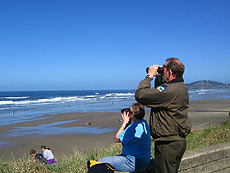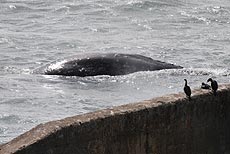 |
Oregon Coast Whale Watching Set Records, Numbers Still Good
Published 01/14/2010
 |
| One of the Whale Watch spots, above Manzanita |
(Depoe Bay, Oregon) – To paraphrase the old Motley Crue song, it's a case of "Whales, whales, whales" on the Oregon coast right now, and it's going to be that way for a little bit longer.
The state's official winter Whale Watch Week may have been over two weeks ago, but the whale counts are still high as they migrate south towards a warmer clime. In fact, this past Whale Watch Week in the last week of December was a record-setting one for the Whale Watching Spoken Here program.
“It was the highest visitor count in five years, and the highest number of whales spotted in five years,” said Morris Grover, head of the Whale Watch Center in Depoe Bay.
 |
| Morris Grover at a spring Whale Watch Week in Nye Beach. |
Under the aegis of Oregon Parks and Recreation Department, the Whale Watching Spoken Here program has been in existence for 33 years now, Grover said. This past Whale Watch Week yielded some major records, as volunteers stood on overlooks across the Oregon coast’s 364 miles for four hours a day and helped visitors spot the giant watery beasts.
“The whale count set an alltime record,”Grover said. “Now, we don’t even have quite all the data in yet, as a few stations haven’t submitted their paperwork yet. But so far, the whale count was 672, and we had 9,134 people come by.”
A bigger surprise to Grover was the number of volunteers who signed up: it was the highest ever, filling up all the spots in some areas.
 |
| Whale out the Whale Watch Center in Depoe Bay (photo courtesy Whale Watch Center) |
“We sold out our volunteer training at the Hatfield in Newport,” Grover said. “We had 60 spots all filled up. We usually get around 35 to 40 volunteers there.”
The reasons for all this weren’t the economy and laid off folks who had nothing better to do or people on vacation. It was the simple standbys of great weather and better publicity. Weather was almost balmy on some days – but certainly calm most of that final week of the year. Smooth conditions on the sea make for actually being able to spot the whales, as they aren’t covered up by high waves, which are a bit like trying to spot wildlife in trenches or below hills.
“We’re coming off a five-year trend of big storms,” Grover said. “Big storms and raging seas have been fairly typical of this time of year. We’ve had things like 105 mph winds before. But not this year.”
From late December through to the end of January, more than 1900 whales will be passing by Oregon’s coast on a southerly jaunt towards the waters of Baja, where females will give birth and other females will get pregnant, only to all return in March as they swim to feeding grounds in the north.
 |
| Photo courtesy Whale Watch Center |
About 18,000 will be gray whales and another 1,100 or so will be Humpback whales. Although most of the herd will be five miles out to sea, plenty will be milling around close to shore, enabling visitors to spot them when calmer seas prevail.
“That works out to something like 30 whales an hour,” Grover said. “Those four weeks are intense.”
Then, just before the beginning of the February, like clockwork, it all nearly completely stops. “You’ll hardly see any in February,” Grover said.
This means there’s another almost two weeks of hot whale watching to be had, but it will definitely depend on the weather. Luckily, the trends for Oregon coast weather have been good for this winter.
Grover points to the fact that no matter how smokin’ the whale action was during that Whale Watch Week, when the big waves kick in, you can kiss a lot of whale spotting goodbye.
 |
| Whale Watch Center, Depoe Bay |
“On December 30th we spotted 242 whales,” Grover said. “But on the 31st, we saw only two. That was when the storms started kicking in.”
The other big factor in the big Whale Watch Week was a big boost in publicity for the event. Most Oregon media – broadcast, internet or print – covered it. Even the smaller papers in small towns on the south coast talked about it.
Grover said there were some interesting discoveries in recent years about whale migrations.
“When October comes, like clockwork, the migration south begins,” he said. “We used to think that it was the juveniles who were leading. But it was being led by pregnant females, ready to give birth.
“And we used to think it was juveniles in the lead when they migrated north in spring. But the first ones up were the newly impregnated females. They’re now eating for two.”More About Depoe Bay lodging.....
 |
 |
 |
RELATED STORIES
Unusual Travel Articles TravelParanormal.com allows you to submit your own creepy tale or debunk one - or see up-to-the-minute news headlines about travel and the paranormal.
Watching Transformations of Oregon Coast Beaches Seasons change and so do beaches, revealing different sides and a variety of eye-popping sights
Staggeringly Cool Ideas for Oregon Coast Romance Be it the season of Valentine's or be it any time of the year, Oregon's coastline has essentially cornered the market for cuddle-inducing possibilities and gushy activities for the hand-holding set
Day or Night Mysteries and Merriment on Oregon Coast It's more than just nightlife that comes to life, but the beaches offer major opportunities
News Headlines from All Over Oregon Need to scan Oregon headlines? Constantly updated news from all over Oregon: a comprehensive, up-to-the-minute display of news headlines from a variety of media.
Secrets of the Season |




































